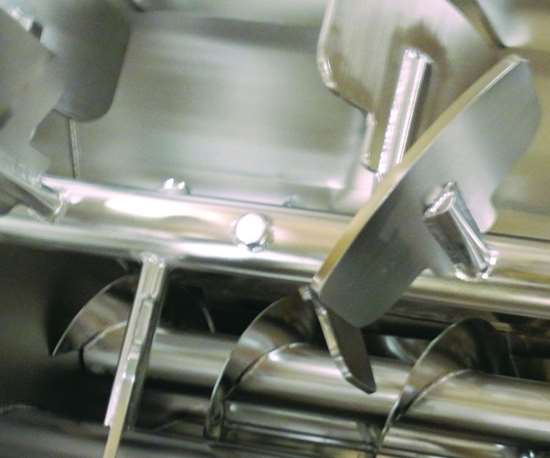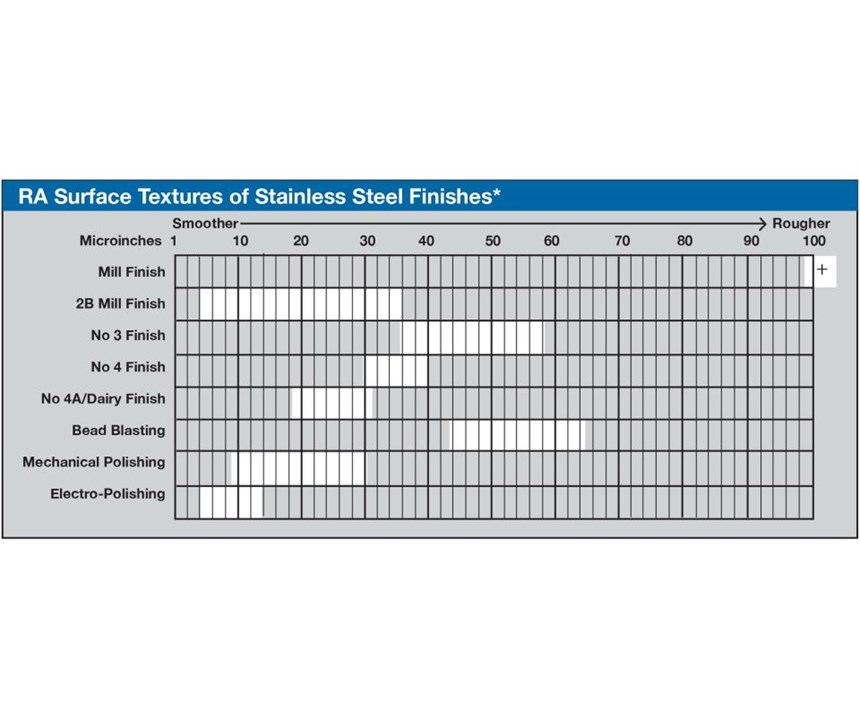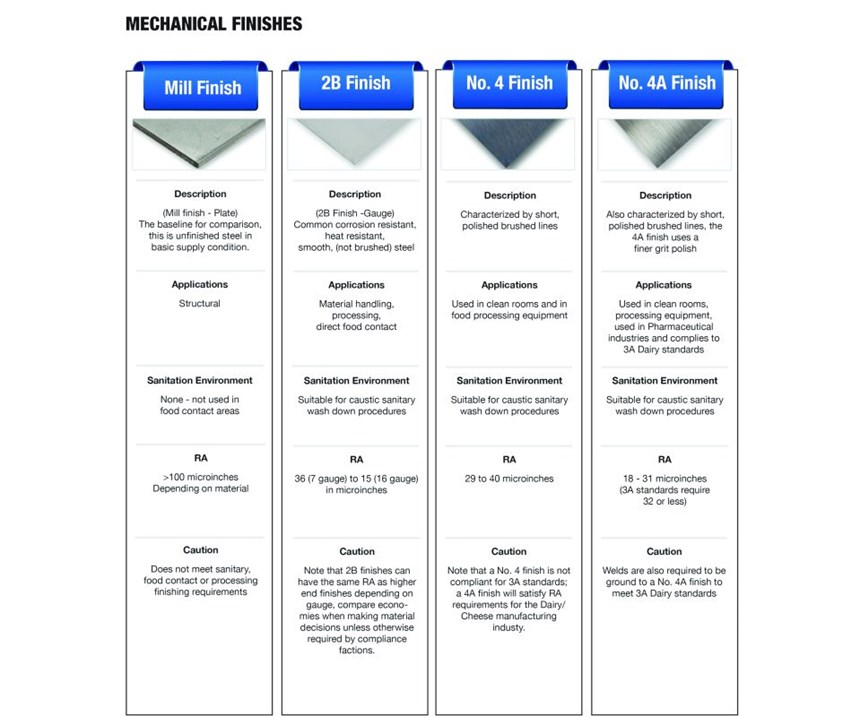For many food and chemical producers, the level of finishing on processing equipment may be prescribed by federal, state and local regulatory agencies. In these sanitary applications, however, the finish, as well as the material, must also be designed for easy and reliable cleaning and sanitation.
Agencies require sanitary finishes to have a minimum roughness average (Ra), but processors also are seeing the advantages of exceeding regulatory compliance, in that higher-end finishes have been proven to decrease sanitation time and decrease bacteria risk.
Featured Content
Here, we provide an educational and informational reference that includes:
- Definitions of stainless finishes and measurement designations.
- An overview of surface textures of stainless steels.
- A general guide to stainless steel finishes.
- Roughness comparison data by finish type.
For original equipment manufacturers, the complexity involved in fabricating sanitary stainless steel equipment is significant. Each industry requires experience and controlled processes. Tooling, process and technique are very important.
The fabrication process starts with selection and handling of the metal. The fundamental process of working with stainless steel in applications with sanitary requirements includes careful handling to prevent contamination from the manufacturing environment and the use of protective surfaces throughout all processes.
Basic Definitions
In sanitary applications, the stainless steel equipment itself requires a sanitary finish. The term “sanitary finish” generally means a smooth, scratch-free, non-corrosive finish. There are several mechanical and chemical finishes that can fulfill agency requirements for sanitary specifications. In choosing the appropriate type of finish, it is important to understand basic definitions and the criteria for how finishes are designated:
Surface texture describes the surface of the material, including irregularities and deviations, and roughness and grain.
Grit is the size of the abrasive used in the polishing process. Typically more coarse, lower grit numbers are associated with grinding, and higher grit numbers are associated with polishing. Grit size alone, however, does not fully define the surface.
Roughness average (Ra) is a standard for an average of the peaks and valleys of the metal’s surface, measured in microinches or micrometers.
Root mean square (RMS) is a machining standard used to diagnose machine operations and surface finish.
The fineness of the finish and ultimate sanitation effectiveness is measured in Ra by height in millionths of an inch or microinches. A profilometer determines values of small surface variations and calculates their average to determine overall roughness.
There are two different types of methods for achieving a polished finish: mechanical and chemical. Mechanical polishing involves the removal of material using an abrasive, mechanical process. Typically, grit sizes of 120 and finer are used for mechanical polishing. Chemical surface treatments remove the outer layer of corrosion on the material to preserve its integrity.
Below is a description of textures and finishes achieved through both mechanical and chemical methods, and commonly used to produce Apache’s tank and vessel-processing equipment, as well as the Mepaco line of food processing equipment.
Types of Textures and Finishes
Mill finish has an unpolished, dull-gray, matte appearance. This finish is the basic supply condition for all stainless steel flat products and also is the basis for additional finishing operations. The material is hot- or cold-rolled with a Ra of more than 100 microinches, depending on its gauge. (Gauge refers to cold-rolled material; plate is hot-rolled material.)
2B mill finish, a widely used stainless steel finish, is common in industrial, chemical and food applications. It is corrosion-resistant and has a typcial Ra range of 40 (7 gauge) to 15 (16 gauge) microinches.
No. 3 finish uses a 120-grit abrasive. It is a semi-polished finish with an Ra range of 36–58 microinches.
No. 4 finish uses a 150-grit abrasive and shows as a polished, brushed surface. The Ra range is 29–40 microinches.
No. 4A/dairy finish, for processing industries, is required to meet the basic 3-A standards. It uses a 180-grit abrasive and has an Ra range of 18–31 microinches.
Bead blasting uses bead material such as glass, ceramic beads or dry ice to produce a non-directional, textured surface with a soft, satin appearance and low reflectivity. The finer the blasting media, the more corrosion-resistant the surface performance. Ra values are typically greater than 45 microinches, but are dependent on the blasting process and the stainless material.
Passivation is the removal of excess iron or iron compounds from the surface of stainless steel by means of a chemical, typically acid-based solution. Unlike pickle passivation, no metal is removed from the surface during the process. It has little effect on the Ra values of the stainless material being passivated.
Pickle passivation is the immersion of the metal in a pickling bath or coating of the material with pickling solution, such as nitric-hydroflouric acid. The process removes both metallic contamination and heat-treating scales. Pickle-passivated stainless steel has a matte appearance. Apache’s tests have confirmed improvements of as much as 25 percent in Ra readings on material that has been pickle-passivated.
Electropolishing is an electrochemical process that removes surface material from stainless steel. It includes an immersion of the stainless steel component into a temperature-controlled bath of electrolyte that is charged with a DC power supply. Electrolytes used in electropolishing are concentrated sulfuric and phosphoric acid solutions. The finish has a mirror appearance. Apache’s before/after tests have shown improvements in Ra ranging to 50 percent; results vary depending on the stainless material.
Apache Testing
While surface standards such as 3-A require smooth, impervious material, free of cracks and crevices, processors also often need to choose the finish that meets those requirements and fits their cleaning processes, risk factors and overall business objectives.
The chart below shows the results of a study conducted at Apache that compares four high-end finishes on 304 stainless steel under 200× magnification. In this study, the electropolished finish is more than six times smoother in Ra readings than the bead-blasted finish. These findings are only significant to a processor if smoother finishes provide the benefit to cleaning and sanitation in its manufacturing processes, however.

Food processing customers have more discretion in choosing equipment finishes, even in food-contact environments. The type of food product, bacterial count, manufacturing function and sanitation procedures all have an impact on their requirements in addition to the selection of equipment finishes.
For weighing the advantages of food-contact equipment finishes, the U.S. Department of Agriculture and Research Service offers a study conducted by the American Society of Mechanical Engineers on electropolishing and surface finishes. In this research, samples of stainless steel finishes were exposed to bacteria to evaluate growth. As microorganisms became attached to surfaces, they became more resistant to both physical and chemical sanitation practices. In testing of 11 different finishes, the electropolished surface was found to be the most resistant to bacterial attachment.
About the Authors
Jessica Jacobson, David Foulkes and Cory Buchholz are with Apache Stainless Equipment Corp. in Beaver Dam, Wisconsin. Visit apachestainless.com.
RELATED CONTENT
-
Glass Bead Blasting as Plating Pretreatment
What are the best practices for using blasting in preparation for plating? Angelo Magrone of Bales Metal Surface Solutions discusses the ins and outs of glass bead blasting.
-
High Fives for the Surface Finishing Industry
National Surface Finishing Day offered what seems to have been a missing component in our makeshift gatherings over the past year, which is a chance to celebrate together.
-
Polishing vs. Buffing: What's the Difference?
Is polishing the same as buffing? Mechanical finishing expert, Pat Wenino, explains the differences between the two processes.
























